Analysis of 1-Aroyl-3-[3-chloro-2-methylphenyl] Thiourea Hybrids as Potent Urease Inhibitors: Synthesis, Biochemical Evaluation and Computational Approach
Abstract
1. Introduction
2. Results and Discussion
2.1. Chemistry
2.2. Spectroscopic Characterization
2.3. Biological Activity
2.3.1. Free Radical Scavenging
2.3.2. In Vitro Urease Inhibitory Activity
2.4. Structure Activity Relationship (SAR)
2.5. Kinetic Analysis
2.6. Computational Studies
2.6.1. Jack Bean Urease Structural Analysis
2.6.2. Binding Pocket Analysis
2.6.3. Molecular Docking
2.6.4. Molecular Dynamics Simulations
2.6.5. Density Functional Theory (DFT)
2.6.6. ADMET Properties
3. Materials and Methods
3.1. General Procedure
3.2. Biological Activities
3.2.1. Free Radical Scavenging Assay
3.2.2. In Vitro Urease Inhibitory Activity
3.2.3. Kinetic Analysis
3.3. Computational Studies
3.3.1. Retrieval of Jack Bean Urease
3.3.2. Preparation of Ligands and Molecular Docking
3.3.3. Molecular Dynamics Simulations
3.3.4. Density Functional Theory
3.3.5. ADMET Properties
4. Conclusions
Supplementary Materials
Author Contributions
Funding
Institutional Review Board Statement
Informed Consent Statement
Data Availability Statement
Acknowledgments
Conflicts of Interest
References
- Khan, Y.M.; Munir, H.; Anwar, Z. Optimization of process variables for enhanced production of urease by indigenous Aspergillus niger strains through response surface methodology. Biocatal. Agric. Biotechnol. 2019, 20, 101202. [Google Scholar] [CrossRef]
- Macegoniuk, K.; Grela, E.; Palus, J.; Rudzinska-Szostak, E.; Grabowiecka, A.; Biernat, M.; Berlicki, Ł. 1,2-Benzisoselenazol-3(2H)-one derivatives as a new class of bacterial urease inhibitors. J. Med. Chem. 2016, 59, 8125–8133. [Google Scholar] [CrossRef] [PubMed]
- Balasubramanian, A.; Ponnuraj, K. Crystal structure of the first plant urease from jack bean: 83 years of journey from its first crystal to molecular structure. J. Mol. Biol. 2010, 400, 274–283. [Google Scholar] [CrossRef]
- Burne, R.A.; Chen, Y.-Y.M. Bacterial ureases in infectious diseases. Microbes Infect. 2000, 2, 533–542. [Google Scholar] [CrossRef]
- Mora, D.; Arioli, S. Microbial urease in health and disease. PLoS Pathog. 2014, 10, e1004472. [Google Scholar] [CrossRef]
- Pervaiz, I.; Ahmad, S.; Arshad, A.; Khurshid, U.; Basit, A. GC-MS metabolic profiling and anti-urease activity of nonpolar fractions of Calligonum Polygonoides L.(Polygonaceae) and Crateva Adansonii DC. Prodr. (Capparaceae). Trop. J. Pharm. Res. 2019, 18, 1955–1960. [Google Scholar] [CrossRef]
- Ahmad, S.; Hassan, A.; Rehman, T.; Basit, A.; Tahir, A.; Arshad, M.A. In vitro bioactivity of extracts from seeds of Cassia absus L. growing in Pakistan. J. Herb. Med. 2019, 16, 100258. [Google Scholar] [CrossRef]
- Basit, A.; Ahmad, S.; Sherif, A.E.; Aati, H.Y.; Ovatlarnporn, C.; Khan, M.A.; Rao, H.; Ahmad, I.; Shahzad, M.N.; Ghalloo, B.A. New mechanistic insights on Justicia vahlii Roth: UPLC-Q-TOF-MS and GC–MS based metabolomics, in-vivo, in-silico toxicological, antioxidant based anti-inflammatory and enzyme inhibition evaluation. Arab. J. Chem. 2022, 15, 104135. [Google Scholar] [CrossRef]
- Khan, K.M.; Iqbal, S.; Lodhi, M.A.; Maharvi, G.M.; Choudhary, M.I.; Perveen, S. Biscoumarin: New class of urease inhibitors; economical synthesis and activity. Bioorganic Med. Chem. 2004, 12, 1963–1968. [Google Scholar] [CrossRef]
- Shakeel, A.; Altaf, A.A.; Qureshi, A.M.; Badshah, A. Thiourea derivatives in drug design and medicinal chemistry: A short review. Drug Des. Med. Chem. 2016, 2, 10. [Google Scholar] [CrossRef]
- Cui, P.; Li, X.; Zhu, M.; Wang, B.; Liu, J.; Chen, H. Design, synthesis and antibacterial activities of thiouracil derivatives containing acyl thiourea as SecA inhibitors. Bioorganic Med. Chem. Lett. 2017, 27, 2234–2237. [Google Scholar] [CrossRef] [PubMed]
- Naureen, S.; Ijaz, F.; Munawar, M.A.; Asif, N.; Chaudhry, F.; Ashraf, M.; Khan, M.A. Synthesis of tetrasubstitutd imidazoles containing indole and their antiurease and antioxidant activities. J. Chil. Chem. Soc. 2017, 62, 3583–3587. [Google Scholar] [CrossRef]
- Mermer, A.; Demirbas, N.; Uslu, H.; Demirbas, A.; Ceylan, S.; Sirin, Y. Synthesis of novel Schiff bases using green chemistry techniques; antimicrobial, antioxidant, antiurease activity screening and molecular docking studies. J. Mol. Struct. 2019, 1181, 412–422. [Google Scholar] [CrossRef]
- Barros, T.G.; Williamson, J.S.; Antunes, O.A.; Muri, E.M. Hydroxamic acids designed as inhibitors of urease. Lett. Drug Des. Discov. 2009, 6, 186–192. [Google Scholar] [CrossRef]
- Khan, E.; Khan, S.; Gul, Z.; Muhammad, M. Medicinal importance, coordination chemistry with selected metals (cu, Ag, au) and Chemosensing of Thiourea derivatives. A review. Crit. Rev. Anal. Chem. 2021, 51, 812–834. [Google Scholar] [CrossRef] [PubMed]
- Hallale, O.; Bourne, S.A.; Koch, K.R. Doubly-linked 1D coordination polymers derived from 2: 2 metallamacrocyclic Ni (ii) complexes with bipodal acylthiourea and exo-bidentate N-donor bridging ligands: Toward potentially selective chemical sensors? New J. Chem. 2005, 29, 1416–1423. [Google Scholar] [CrossRef]
- Du, W.; Curran, D.P. Synthesis of carbocyclic and heterocyclic fused quinolines by cascade radical annulations of unsaturated N-aryl thiocarbamates, thioamides, and thioureas. Org. Lett. 2003, 5, 1765–1768. [Google Scholar] [CrossRef]
- Channar, S.A.; Channar, P.A.; Saeed, A.; Alsfouk, A.A.; Ejaz, S.A.; Ujan, R.; Noor, R.; Bilal, M.S.; Abbas, Q.; Hussain, Z. Exploring thiazole-linked thioureas using alkaline phosphatase assay, biochemical evaluation, computational analysis and structure–activity relationship (SAR) studies. Med. Chem. Res. 2022, 31, 1792–1802. [Google Scholar] [CrossRef]
- Abdul Fattah, T.; Saeed, A.; Channar, P.A.; Ashraf, Z.; Abbas, Q.; Hassan, M.; Larik, F.A. Synthesis, enzyme inhibitory kinetics, and computational studies of novel 1-(2-(4-isobutylphenyl) propanoyl)-3-arylthioureas as Jack bean urease inhibitors. Chem. Biol. Drug Des. 2018, 91, 434–447. [Google Scholar] [CrossRef]
- Madasu, C.; Karri, S.; Sangaraju, R.; Sistla, R.; Uppuluri, M.V. Synthesis and biological evaluation of some novel 1,2,3-triazole hybrids of myrrhanone B isolated from Commiphora mukul gum resin: Identification of potent antiproliferative leads active against prostate cancer cells (PC-3). Eur. J. Med. Chem. 2020, 188, 111974. [Google Scholar] [CrossRef]
- Sevvanthi, S.; Muthu, S.; Raja, M. Molecular docking, vibrational spectroscopy studies of (RS)-2-(tert-butylamino)-1-(3-chlorophenyl)propan-1-one: A potential adrenaline uptake inhibitor. J. Mol. Struct. 2018, 1173, 251–260. [Google Scholar] [CrossRef]
- Sakthivel, S.; Alagesan, T.; Muthu, S.; Abraham, C.S.; Geetha, E. Quantum mechanical, spectroscopic study (FT-IR and FT-Raman), NBO analysis, HOMO-LUMO, first order hyperpolarizability and docking studies of a non-steroidal anti-inflammatory compound. J. Mol. Struct. 2018, 1156, 645–656. [Google Scholar] [CrossRef]
- Bhavani, K.; Renuga, S.; Muthu, S. Quantum mechanical study and spectroscopic (FT-IR, FT-Raman, 13C, 1H) study, first order hyperpolarizability, NBO analysis, HOMO and LUMO analysis of 2-acetoxybenzoic acid by density functional methods. Spectrochim. Acta Part A Mol. Biomol. Spectrosc. 2015, 136, 1260–1268. [Google Scholar] [CrossRef] [PubMed]
- Choudhary, M.I.; Shaikh, M.; tul-Wahab, A.; ur-Rahman, A. In silico identification of potential inhibitors of key SARS-CoV-2 3CL hydrolase (Mpro) via molecular docking, MMGBSA predictive binding energy calculations, and molecular dynamics simulation. PLoS ONE 2020, 15, e0235030. [Google Scholar] [CrossRef]
- Channar, P.A.; Saeed, A.; Albericio, F.; Larik, F.A.; Abbas, Q.; Hassan, M.; Raza, H.; Seo, S.-Y. Sulfonamide-linked ciprofloxacin, sulfadiazine and amantadine derivatives as a novel class of inhibitors of jack bean urease; synthesis, kinetic mechanism and molecular docking. Molecules 2017, 22, 1352. [Google Scholar] [CrossRef]
- Hanif, M.; Kanwal, F.; Rafiq, M.; Hassan, M.; Mustaqeem, M.; Seo, S.-Y.; Zhang, Y.; Lu, C.; Chen, T.; Saleem, M. Symmetrical heterocyclic cage skeleton: Synthesis, urease inhibition activity, kinetic mechanistic insight, and molecular docking analyses. Molecules 2019, 24, 312. [Google Scholar] [CrossRef]
- Saeed, A.; Larik, F.A.; Channar, P.A.; Mehfooz, H.; Ashraf, M.H.; Abbas, Q.; Hassan, M.; Seo, S.Y. An expedient synthesis of N-(1-(5-mercapto-4-((substituted benzylidene)amino)-4H-1,2,4-triazol-3-yl)-2-phenylethyl)benzamides as jack bean urease inhibitors and free radical scavengers: Kinetic mechanism and molecular docking studies. Chem. Biol. Drug Des. 2017, 90, 764–777. [Google Scholar] [CrossRef]
- Berman, H.; Henrick, K.; Nakamura, H. Announcing the worldwide protein data bank. Nat. Struct. Mol. Biol. 2003, 10, 980. [Google Scholar] [CrossRef]
- Pettersen, E.F.; Goddard, T.D.; Huang, C.C.; Couch, G.S.; Greenblatt, D.M.; Meng, E.C.; Ferrin, T.E. UCSF Chimera—A visualization system for exploratory research and analysis. J. Comput. Chem. 2004, 25, 1605–1612. [Google Scholar] [CrossRef]
- BIOVIA. Dassault Systèmes, Discovery Studio Visualizer 17.2; Dassault Systèmes: San Diego, CA, USA, 2005. [Google Scholar]
- Willard, L.; Ranjan, A.; Zhang, H.; Monzavi, H.; Boyko, R.F.; Sykes, B.D.; Wishart, D.S. VADAR: A web server for quantitative evaluation of protein structure quality. Nucleic Acids Res. 2003, 31, 3316–3319. [Google Scholar] [CrossRef]
- Dallakyan, S.; Olson, A.J. Small-molecule library screening by docking with PyRx. In Chemical Biology; Springer: Berlin/Heidelberg, Germany, 2015; pp. 243–250. [Google Scholar]
- Phillips, J.C.; Braun, R.; Wang, W.; Gumbart, J.; Tajkhorshid, E.; Villa, E.; Chipot, C.; Skeel, R.D.; Kale, L.; Schulten, K. Scalable molecular dynamics with NAMD. J. Comput. Chem. 2005, 26, 1781–1802. [Google Scholar] [CrossRef] [PubMed]
- Bussi, G.; Donadio, D.; Parrinello, M. Canonical sampling through velocity rescaling. J. Chem. Phys. 2007, 126, 014101. [Google Scholar] [CrossRef] [PubMed]
- Parrinello, M.; Rahman, A. Polymorphic transitions in single crystals: A new molecular dynamics method. J. Appl. Phys. 1981, 52, 7182–7190. [Google Scholar] [CrossRef]
- Humphrey, W.; Dalke, A.; Schulten, K. VMD: Visual molecular dynamics. J. Mol. Graph. 1996, 14, 33–38. [Google Scholar] [CrossRef]
- Liu, L.; Kupiainen-Määttä, O.; Zhang, H.; Li, H.; Zhong, J.; Kurten, T.; Vehkamäki, H.; Zhang, S.; Zhang, Y.; Ge, M. Clustering mechanism of oxocarboxylic acids involving hydration reaction: Implications for the atmospheric models. J. Chem. Phys. 2018, 148, 214303. [Google Scholar] [CrossRef]
- Tüzün, B.; Bhawsar, J. Quantum chemical study of thiaozole derivatives as corrosion inhibitors based on density functional theory. Arab. J. Chem. 2021, 14, 102927. [Google Scholar] [CrossRef]
- Abbasi, M.A.; Raza, H.; Siddiqui, S.Z.; Shah, S.A.A.; Hassan, M.; Seo, S.-Y. Synthesis of novel N-(1,3-thiazol-2-yl)benzamide clubbed oxadiazole scaffolds: Urease inhibition, Lipinski rule and molecular docking analyses. Bioorganic Chem. 2019, 83, 63–75. [Google Scholar] [CrossRef]
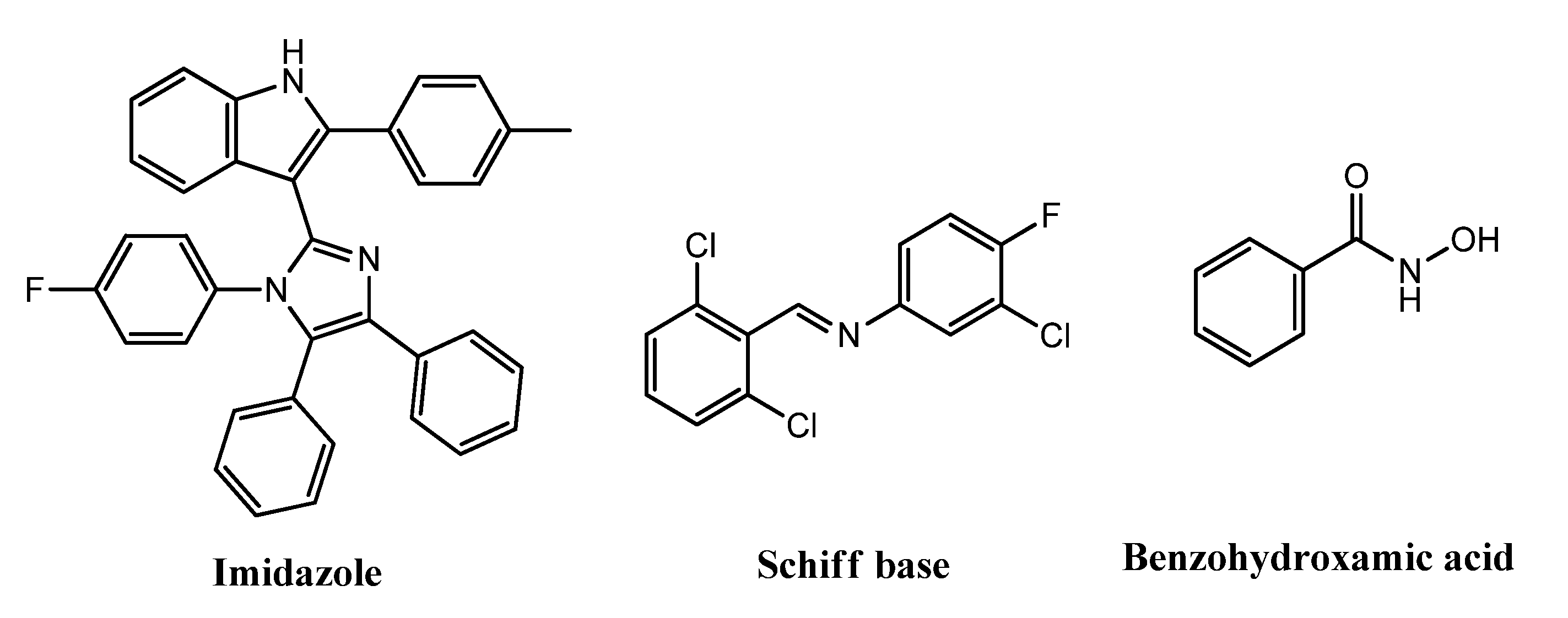
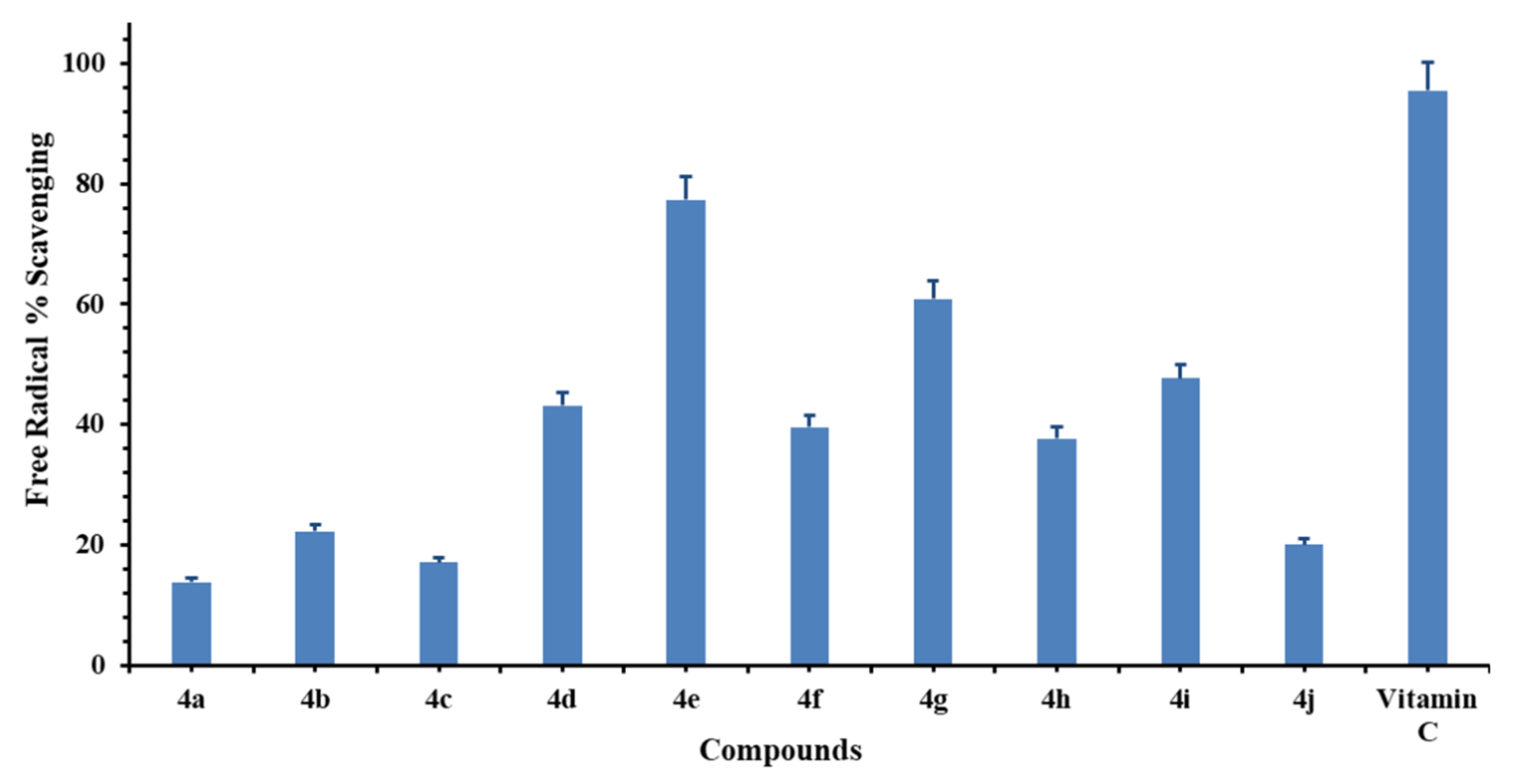
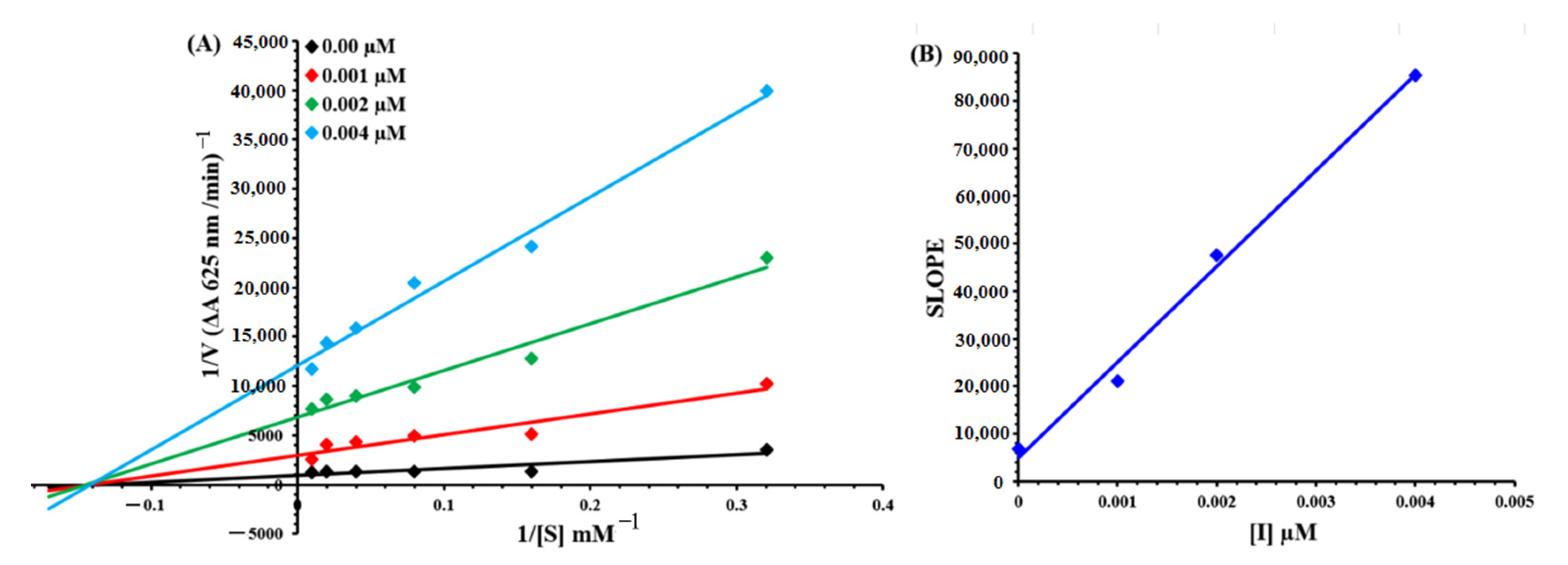
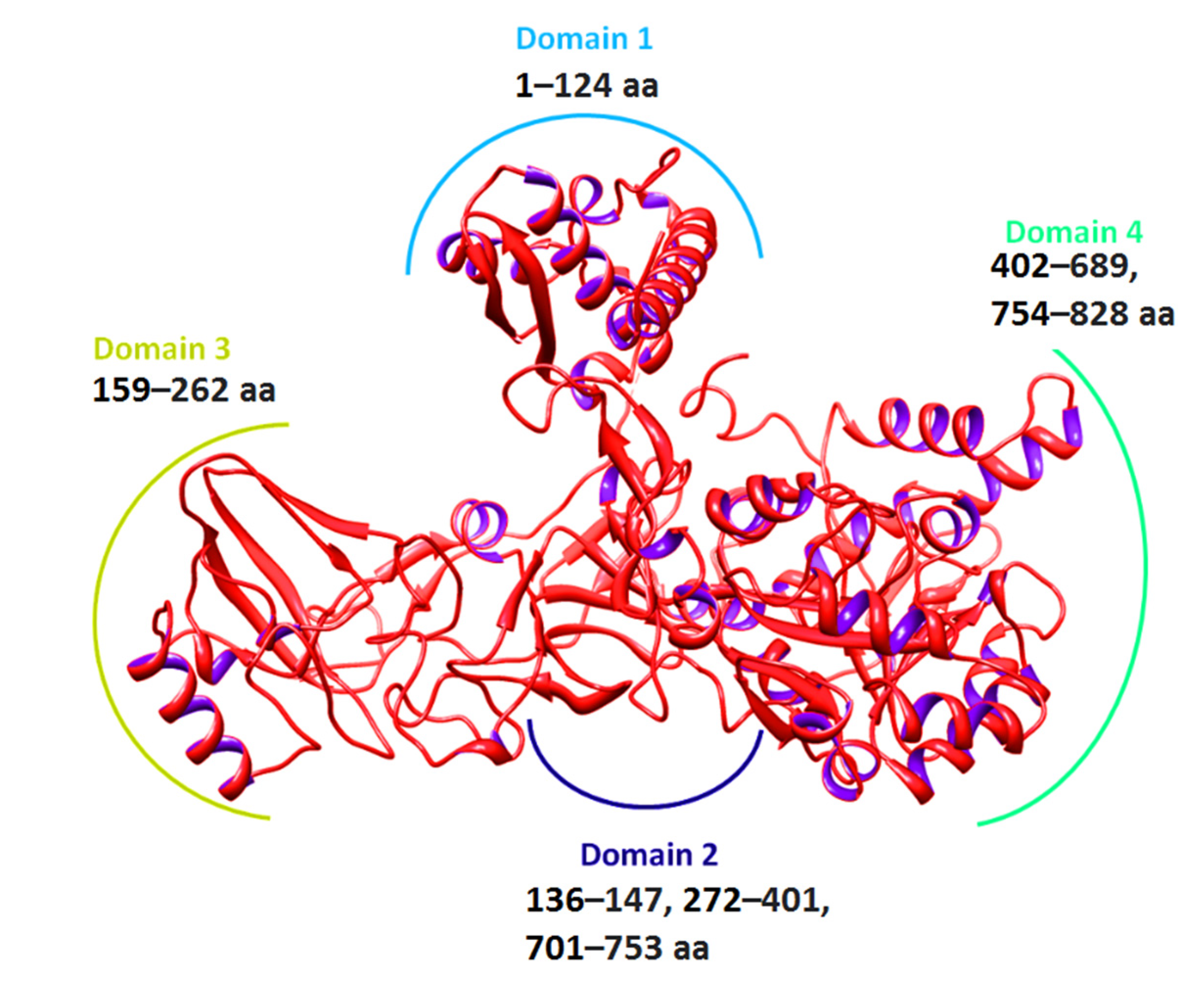
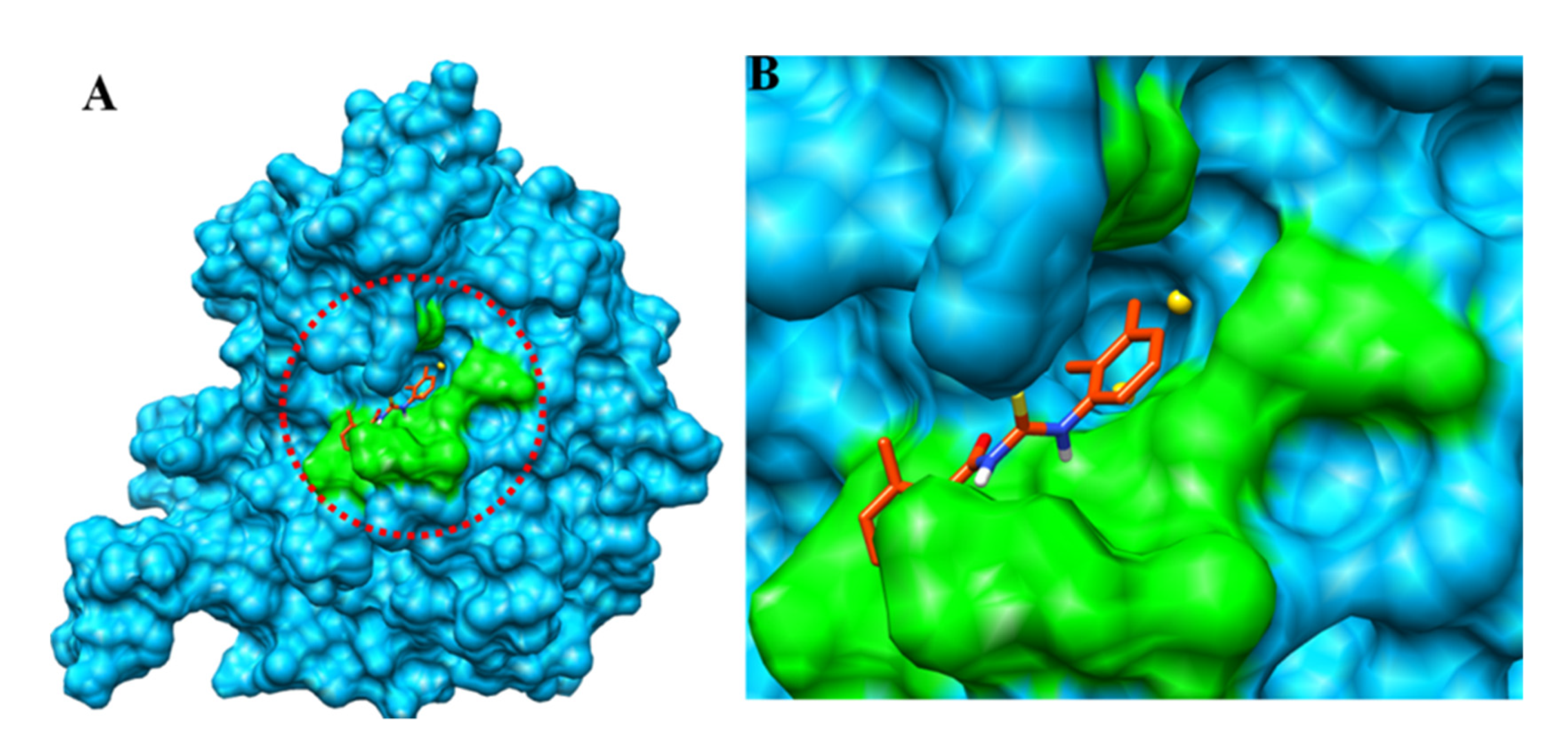

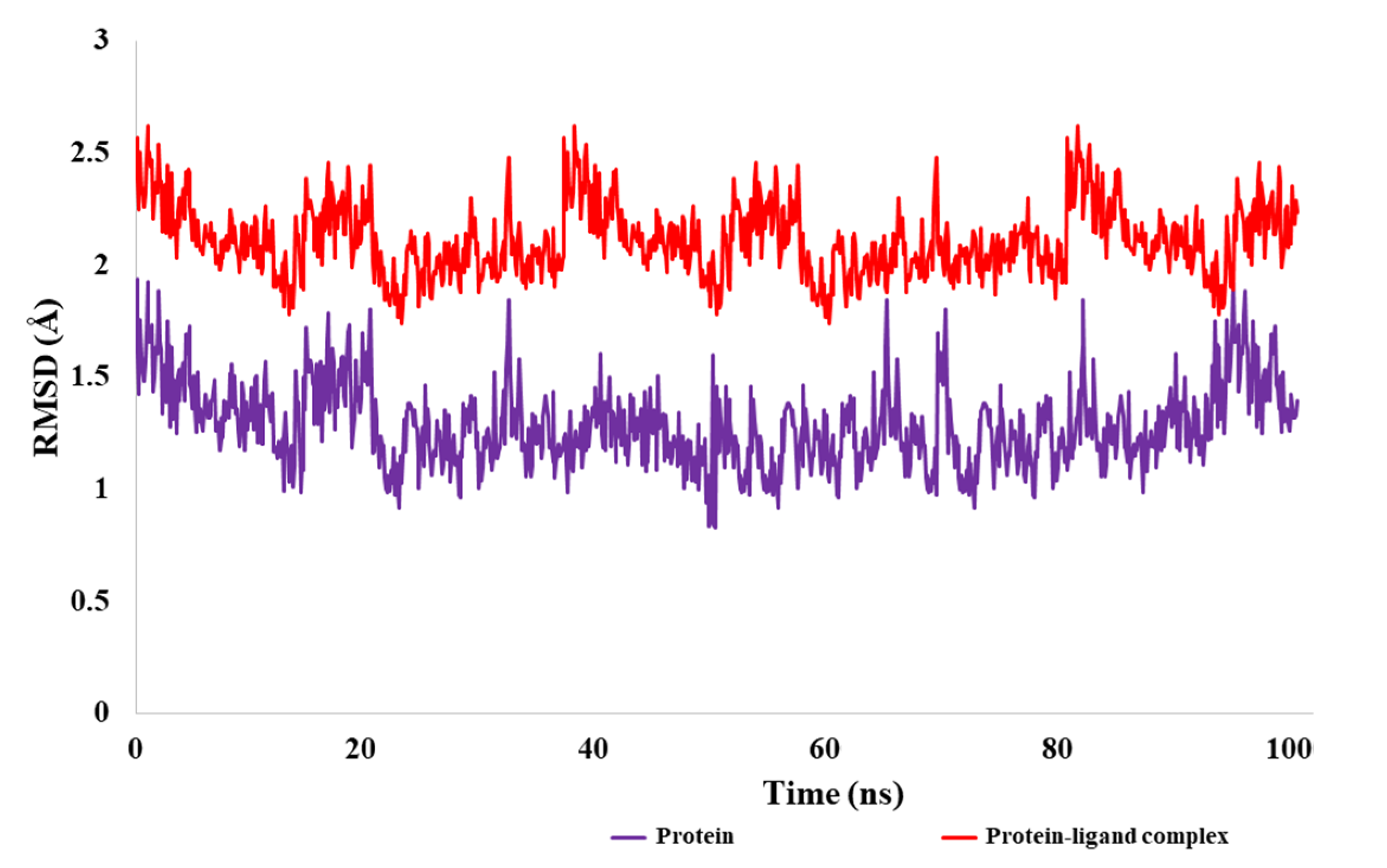

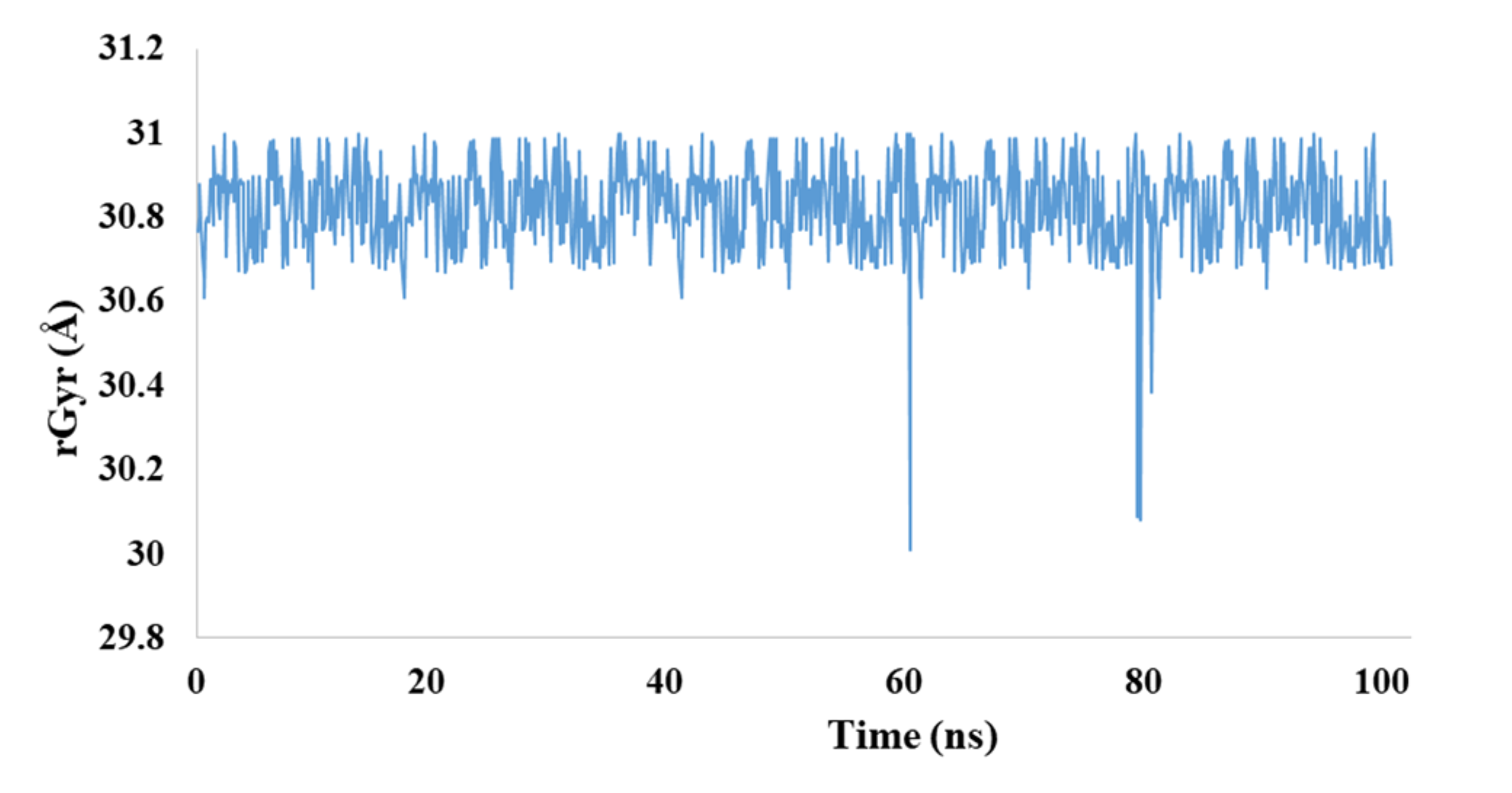

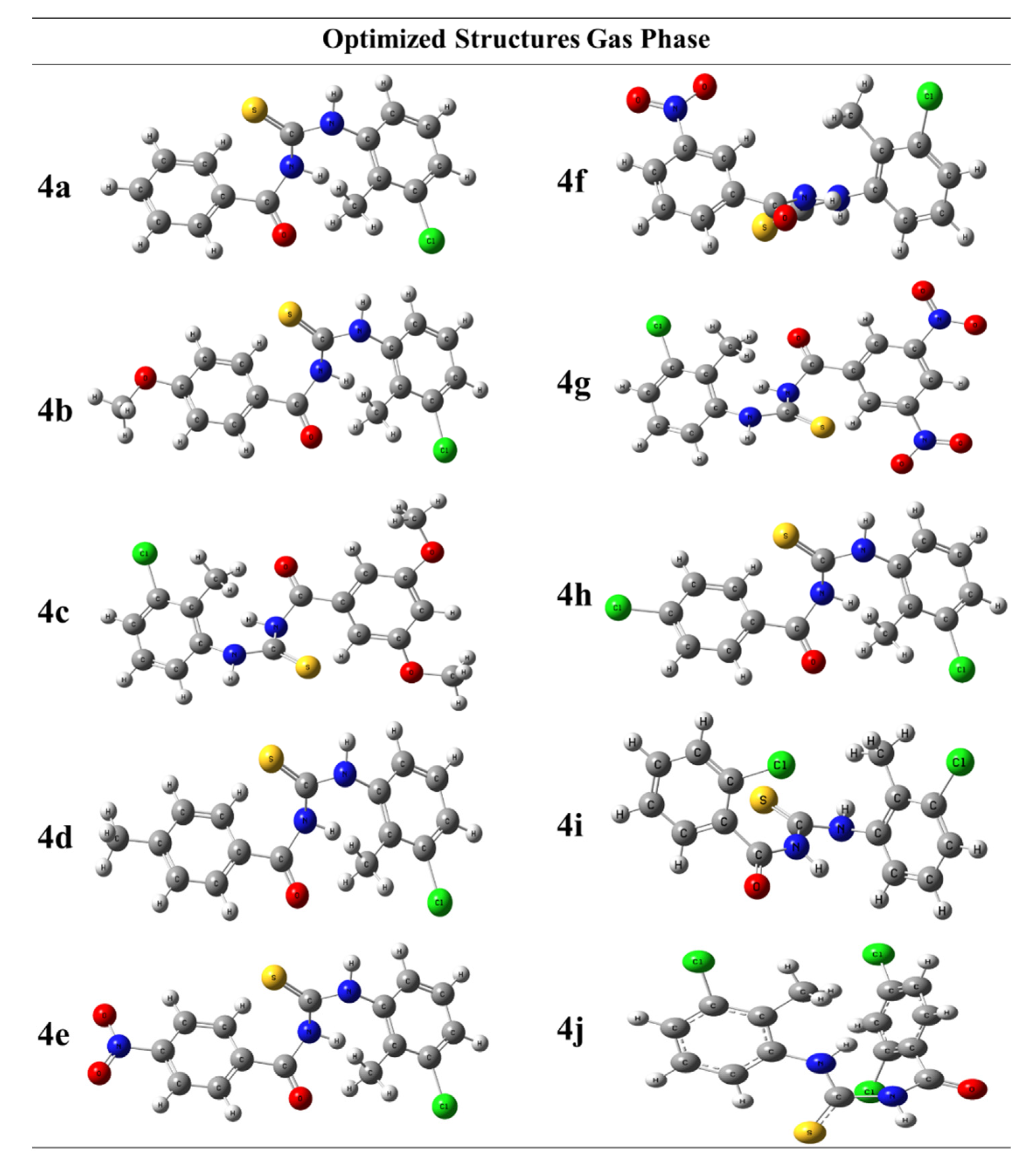
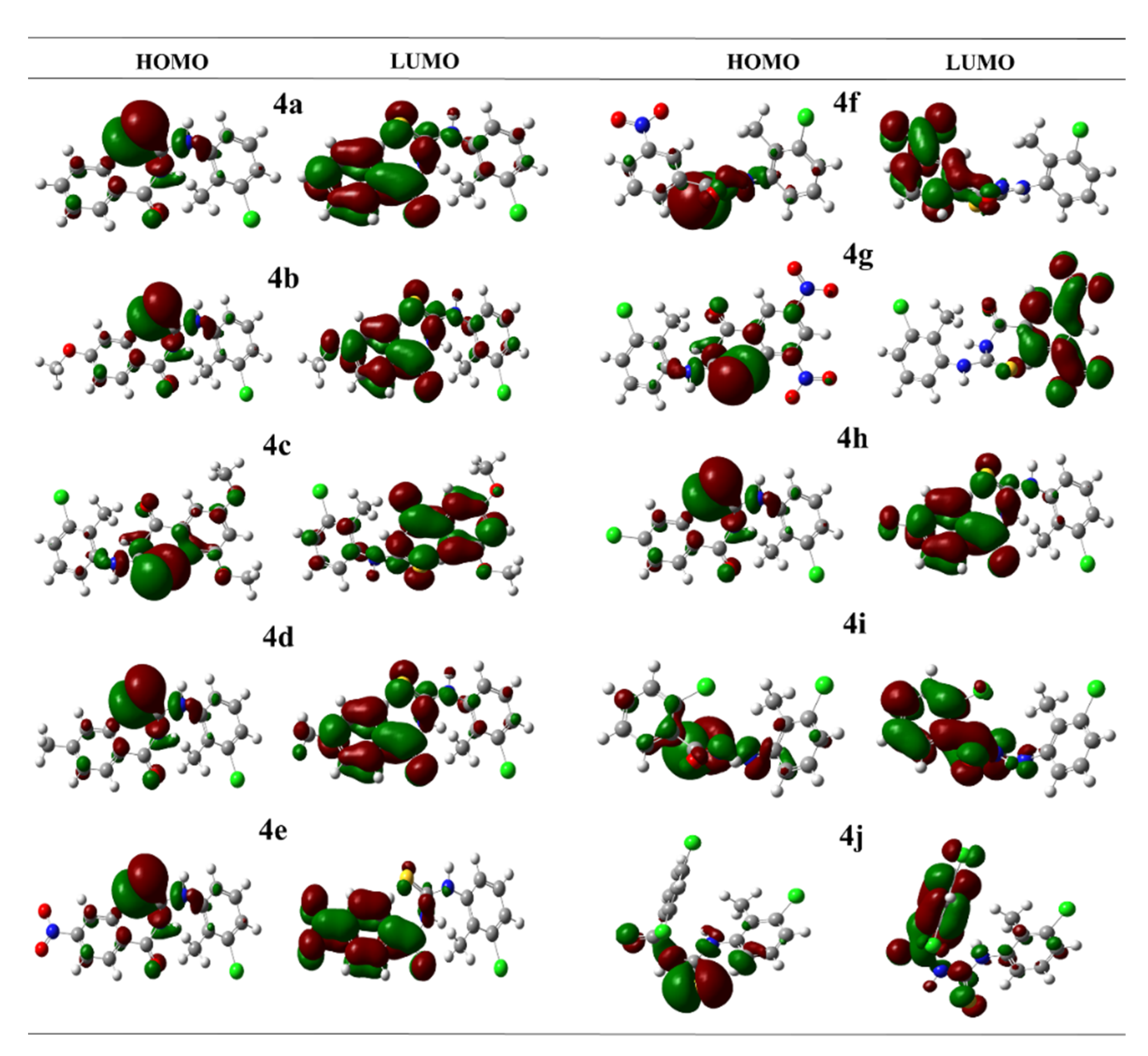

| Compound | Urease Activity IC50 ± SEM [µM] | Compound | Urease Activity IC50 ± SEM [µM] |
|---|---|---|---|
| 4a | 0.0449 ± 0.0854 | 4f | 0.0136 ± 0.0544 |
| 4b | 0.0079 ± 0.0048 | 4g | 0.0335 ± 0.0994 |
| 4c | 0.0131 ± 0.2657 | 4h | 0.0229 ± 0.0774 |
| 4d | 0.0532 ± 0.0995 | 4i | 0.0019 ± 0.0011 |
| 4e | 0.0038 ± 0.0784 | 4j | 0.0101 ± 0.8677 |
| Thiourea | 4.7455 ± 0.0545 | ||
| Concentration | Vmax [ΔA/Min] | Km [mM] | Inhibition Type | Ki [µM] |
|---|---|---|---|---|
| 0.00 | 0.000793 | 6.67 | Non-Competitive | 0.0003 |
| 0.001 | 0.000387 | 6.67 | ||
| 0.002 | 0.000131 | 6.67 | ||
| 0.004 | 8.49548 × 10−5 | 6.67 |
| Code | HOMO [eV] | LUMO [eV] | HOMO-LUMO [ΔeV] |
|---|---|---|---|
| 4a | −0.103 | 0.031 | 0.071 |
| 4b | −0.098 | 0.038 | 0.060 |
| 4c | −0.097 | 0.039 | 0.058 |
| 4d | −0.101 | 0.032 | 0.069 |
| 4e | −0.112 | 0.002 | 0.109 |
| 4f | −0.110 | 0.008 | 0.101 |
| 4g | −0.109 | 0.006 | 0.114 |
| 4h | −0.109 | 0.019 | 0.090 |
| 4i | −0.10274 | 0.02728 | 0.07546 |
| 4j | −0.12054 | 0.02354 | 0.097 |
| Physicochemical Properties | ||||||||
|---|---|---|---|---|---|---|---|---|
| Molecular Weight | Density | nHA | nHD | TPSA | LogS | LogP | LogD | |
| 1 | 304.04 | 0.985 | 3 | 2 | 41.13 | −5.384 | 4.129 | 3.919 |
| 2 | 334.05 | 0.991 | 4 | 2 | 50.36 | −5.915 | 4.218 | 3.859 |
| 3 | 364.06 | 0.986 | 5 | 2 | 59.59 | −6.107 | 4.43 | 3.776 |
| 4 | 318.06 | 0.983 | 3 | 2 | 41.13 | −6.034 | 4.623 | 4.138 |
| 5 | 349.03 | 0.983 | 6 | 2 | 84.27 | −5.882 | 4.091 | 4.14 |
| 6 | 349.03 | 0.983 | 6 | 2 | 84.27 | −5.729 | 4.053 | 4.093 |
| 7 | 394.01 | 0.978 | 9 | 2 | 127.41 | −5.567 | 3.972 | 3.783 |
| 8 | 338.0 | 0.978 | 3 | 2 | 41.13 | −6.288 | 4.874 | 4.198 |
| 9 | 332.08 | 0.978 | 3 | 2 | 41.13 | −5.983 | 4.579 | 4.137 |
| 10 | 371.97 | 0.978 | 3 | 2 | 41.13 | −6.781 | 5.233 | 3.865 |
| ABSORPTION & DISTRIBUTION PROPERTIES | ||||||||||||||||
|---|---|---|---|---|---|---|---|---|---|---|---|---|---|---|---|---|
| VOLUME OF DISTRIBUTION [VD] | HUMAN INTESTINAL ABSORPTION [HIA] | CACO-2 PERMEABILITY | BLOOD BRAIN BARRIER [BBB] & BLOOD-PLACENTA BARRIER [BPB | PLASMA PROTEIN BINDING [PPB] | PGP-INHIBITOR | P-GLYCOPROTEIN SUBSTRATE [PGP-SUBSTRATE] | MDCK PERMEABILITY | |||||||||
| Mode | Result | Probability | Result | Probability | Result | Probability | Result | Probability | Result | Probability | Result | Probability | Result | Probability | Result | Probability |
| 1 | + | 0.652 | + | 0.039 | + | −4.923 | + | 0.883 | − | 97.79% | + | 0.001 | + | 0.009 | + | 7.5 × 10−5 |
| 2 | + | 0.789 | + | 0.015 | + | −5.007 | + | 0.761 | − | 98.48% | + | 0.004 | + | 0.009 | + | 4.9 × 10−5 |
| 3 | + | 0.942 | + | 0.013 | − | −5.409 | + | 0.397 | − | 99.77% | + | 0.066 | + | 0.069 | + | 3.8 × 10−5 |
| 4 | + | 0.746 | + | 0.006 | + | −4.924 | + | 0.738 | − | 98.31% | + | 0.005 | + | 0.008 | + | 4.8 × 10−5 |
| 5 | + | 0.808 | + | 0.017 | + | −4.964 | + | 0.46 | − | 99.07% | + | 0.003 | + | 0.003 | + | 0.000199 |
| 6 | + | 0.941 | + | 0.022 | + | −4.987 | + | 0.511 | − | 99.30% | + | 0.003 | + | 0.003 | + | 0.000198 |
| 7 | + | 1.36 | + | 0.015 | + | −5.084 | + | 0.268 | − | 100.6% | + | 0.025 | + | 0.003 | + | 0.000285 |
| 8 | + | 0.77 | + | 0.012 | + | −4.866 | + | 0.608 | − | 99.37% | + | 0.002 | + | 0.005 | + | 3.7 × 10−5 |
| 9 | + | 0.726 | + | 0.007 | + | −4.92 | + | 0.74 | − | 98.75% | + | 0.014 | + | 0.017 | + | 5.6 × 10−5 |
| 10 | + | 1.383 | + | 0.005 | + | −4.948 | + | 0.431 | − | 100.5% | + | 0.004 | + | 0.004 | + | 2.4 × 10−5 |
| METABOLISM | EXCRETION | |||||||||||||||
| CYP1A2 inhibitor | CYP2C19 inhibitor | CYP2C9 inhibitor | CYP2D6 inhibitor | CYP3A4 inhibitor | CL | T1/2 | ||||||||||
| 1 | 0.923 | 0.934 | 0.922 | 0.09 | 0.57 | − | 4.221 | − | 0.732 | |||||||
| 2 | 0.761 | 0.854 | 0.926 | 0.357 | 0.758 | + | 5.521 | − | 0.557 | |||||||
| 3 | 0.89 | 0.902 | 0.911 | 0.41 | 0.916 | + | 7.985 | − | 0.661 | |||||||
| 4 | 0.719 | 0.831 | 0.922 | 0.188 | 0.665 | − | 4.271 | − | 0.537 | |||||||
| 5 | 0.685 | 0.757 | 0.892 | 0.265 | 0.537 | − | 2.645 | − | 0.341 | |||||||
| 6 | 0.839 | 0.855 | 0.918 | 0.395 | 0.812 | − | 2.8 | − | 0.462 | |||||||
| 7 | 0.759 | 0.771 | 0.909 | 0.402 | 0.826 | − | 2.03 | − | 0.325 | |||||||
| 8 | 0.876 | 0.917 | 0.928 | 0.47 | 0.535 | − | 3.38 | − | 0.375 | |||||||
| 9 | 0.87 | 0.908 | 0.936 | 0.324 | 0.761 | − | 4.506 | − | 0.525 | |||||||
| 10 | 0.858 | 0.91 | 0.938 | 0.394 | 0.499 | − | 3.836 | − | 0.189 | |||||||
| MEDICINAL PROPERTIES | TOXICITY | |||||||||||||||
| Synthetic Accessibility Score | Lipinski Rule | AMES Toxicity | Carcinogenicity | Eye Corrosion | Eye Irritation | Respiratory Toxicity | ||||||||||
| Result | Probability | Result | Probability | Result | Probability | Result | Probability | Result | Probability | Result | Probability | Result | Probability | |||
| 1 | + | 1.68 | + | Accepted | − | 0.251 | − | 0.468 | + | 0.003 | + | 0.197 | + | 0.075 | ||
| 2 | + | 1.74 | + | Accepted | − | 0.449 | − | 0.775 | + | 0.003 | + | 0.117 | + | 0.087 | ||
| 3 | + | 1.97 | + | Accepted | − | 0.209 | − | 0.698 | + | 0.003 | + | 0.071 | + | 0.199 | ||
| 4 | + | 1.73 | + | Accepted | − | 0.346 | − | 0.587 | + | 0.003 | + | 0.143 | + | 0.043 | ||
| 5 | + | 1.91 | + | Accepted | − | 0.963 | − | 0.765 | + | 0.003 | + | 0.263 | + | 0.387 | ||
| 6 | + | 1.95 | + | Accepted | − | 0.951 | − | 0.746 | + | 0.003 | + | 0.201 | + | 0.389 | ||
| 7 | + | 2.24 | + | Accepted | − | 0.984 | − | 0.846 | + | 0.003 | + | 0.157 | − | 0.935 | ||
| 8 | + | 1.75 | + | Accepted | − | 0.221 | − | 0.444 | + | 0.003 | + | 0.117 | + | 0.052 | ||
| 9 | + | 1.93 | + | Accepted | − | 0.367 | − | 0.513 | + | 0.003 | + | 0.197 | + | 0.036 | ||
| 10 | + | 1.91 | + | Accepted | − | 0.184 | − | 0.391 | + | 0.003 | + | 0.109 | + | 0.043 | ||
| TOX21 PATHWAY | ||||||||||||||||
| NR-AR | NR-AR-LBD | NR-ER | Anti-oxidant Response Element | |||||||||||||
| Result | Probability | Result | Probability | Result | Probability | Result | Probability | |||||||||
| 1 | + | 0.006 | + | 0.003 | + | 0.135 | + | 0.494 | ||||||||
| 2 | + | 0.009 | + | 0.003 | + | 0.153 | + | 0.672 | ||||||||
| 3 | + | 0.017 | + | 0.004 | - | 0.138 | + | 0.491 | ||||||||
| 4 | + | 0.006 | + | 0.003 | + | 0.134 | + | 0.434 | ||||||||
| 5 | + | 0.01 | + | 0.009 | + | 0.194 | − | 0.844 | ||||||||
| 6 | + | 0.009 | + | 0.011 | + | 0.167 | − | 0.786 | ||||||||
| 7 | + | 0.012 | + | 0.255 | + | 0.255 | − | 0.94 | ||||||||
| 8 | + | 0.006 | + | 0.003 | + | 0.155 | − | 0.724 | ||||||||
| 9 | + | 0.009 | + | 0.003 | + | 0.122 | + | 0.393 | ||||||||
| 10 | + | 0.011 | + | 0.003 | + | 0.146 | − | 0.826 | ||||||||
Publisher’s Note: MDPI stays neutral with regard to jurisdictional claims in published maps and institutional affiliations. |
© 2022 by the authors. Licensee MDPI, Basel, Switzerland. This article is an open access article distributed under the terms and conditions of the Creative Commons Attribution (CC BY) license (https://creativecommons.org/licenses/by/4.0/).
Share and Cite
Rasheed, S.; Aziz, M.; Saeed, A.; Ejaz, S.A.; Channar, P.A.; Zargar, S.; Abbas, Q.; Alanazi, H.; Hussain, M.; Alharbi, M.; et al. Analysis of 1-Aroyl-3-[3-chloro-2-methylphenyl] Thiourea Hybrids as Potent Urease Inhibitors: Synthesis, Biochemical Evaluation and Computational Approach. Int. J. Mol. Sci. 2022, 23, 11646. https://doi.org/10.3390/ijms231911646
Rasheed S, Aziz M, Saeed A, Ejaz SA, Channar PA, Zargar S, Abbas Q, Alanazi H, Hussain M, Alharbi M, et al. Analysis of 1-Aroyl-3-[3-chloro-2-methylphenyl] Thiourea Hybrids as Potent Urease Inhibitors: Synthesis, Biochemical Evaluation and Computational Approach. International Journal of Molecular Sciences. 2022; 23(19):11646. https://doi.org/10.3390/ijms231911646
Chicago/Turabian StyleRasheed, Samina, Mubashir Aziz, Aamer Saeed, Syeda Abida Ejaz, Pervaiz Ali Channar, Seema Zargar, Qamar Abbas, Humidah Alanazi, Mumtaz Hussain, Mona Alharbi, and et al. 2022. "Analysis of 1-Aroyl-3-[3-chloro-2-methylphenyl] Thiourea Hybrids as Potent Urease Inhibitors: Synthesis, Biochemical Evaluation and Computational Approach" International Journal of Molecular Sciences 23, no. 19: 11646. https://doi.org/10.3390/ijms231911646
APA StyleRasheed, S., Aziz, M., Saeed, A., Ejaz, S. A., Channar, P. A., Zargar, S., Abbas, Q., Alanazi, H., Hussain, M., Alharbi, M., Kim, S. J., Wani, T. A., & Raza, H. (2022). Analysis of 1-Aroyl-3-[3-chloro-2-methylphenyl] Thiourea Hybrids as Potent Urease Inhibitors: Synthesis, Biochemical Evaluation and Computational Approach. International Journal of Molecular Sciences, 23(19), 11646. https://doi.org/10.3390/ijms231911646







